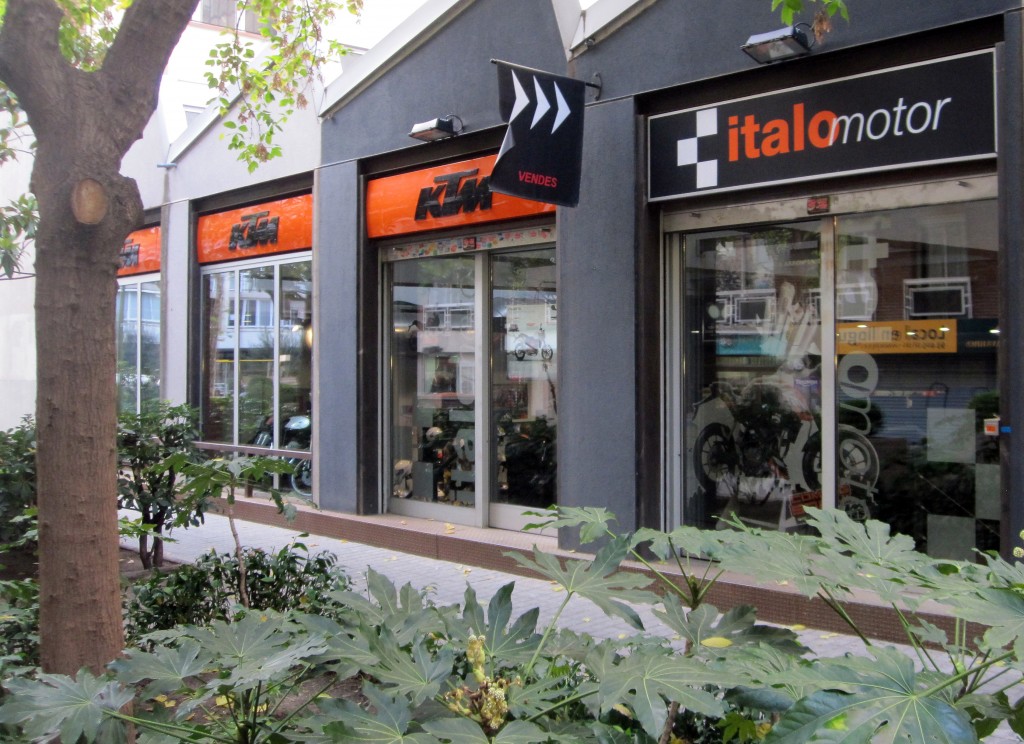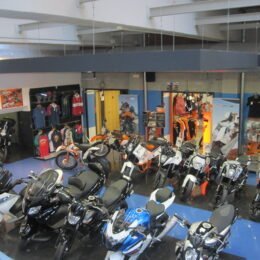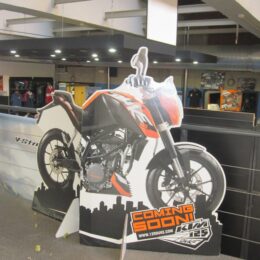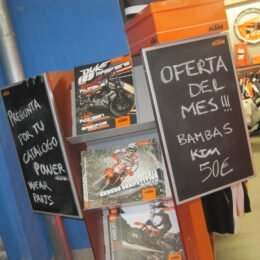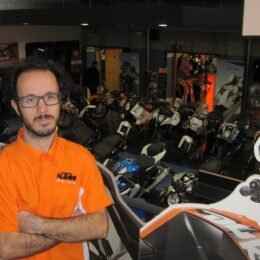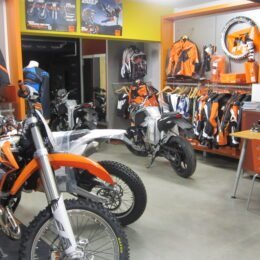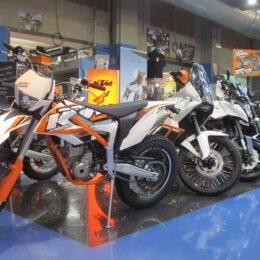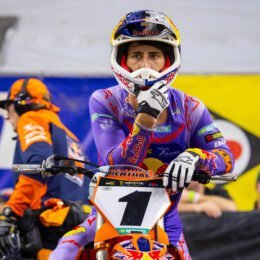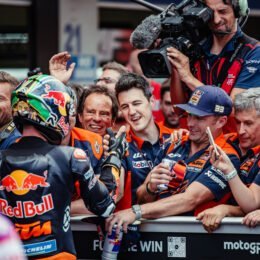KTM Corners of the world: Barcelona
The first in our series of ‘orange’ locations around the world sees the focus fall on Catalunya. Squashed between the Tibidabo mountain and the Mediterranean Sea is one of Europe’s finest and most charismatic cities. Among the bustle of two million inhabitants living, working and commuting within zones like Eixample, Gracia and Barri Gotic lies KTM’s hot spot for the Catalan capital. Italomotor, located in Calle Numancia since 2005, only five minutes drive from the iconic Camp Nou football stadium, has been the source for Barcelona’s KTM ‘face’ for almost ten years so we went along to see who is buying what bikes and gain a bit of insight into the life of a motorcycle dealership. Christian Cirera was there to answer some of our questions…
How many people work here at Italomotor?
We have three brands under this roof and a person responsible for sales and purchasing for each one. We all work together but usually there is one member of staff specialising for each company, my brother Eric services KTM. We have someone responsible for spares and then a co-ordinator of the workshop with five mechanics; one of those is specialist in KTM street models and off-road while another is mainly for the off-road models in terms of set-up and competition prep. In total we have two shops and thirteen staff.
You are based very centrally and close to a major shopping centre. Is that important?
There is no special reason. In some places it makes sense to be in industrial zones because it is cheaper to buy or rent the space. You could have more shop floor and it might be easier to park. I think it is different for car dealerships in Barcelona but when it comes to bikes people always like to have their possibilities for looking, trying and buying close to hand. So trying to find the right spot was the challenge and we are happy where we are.
It has been a hard time for the motorcycling industry over the last few years but has something like the workshop always kept good business?
There are always fluctuations and the workshop is something that is also affected but to a lesser degree. Why? Because if you offer a good service to the client then you can pretty much count on them again. When it comes to sales there are always potential customers because if someone buys a bike here and we do a good job of the process then they will also become a client in the workshop for servicing or repair. Naturally in moments of hard crisis there might be less people buying new bikes but there is more chance that former customers need work done to old or existing machinery. There are things you can try, such as special promotions and things like little seminars for people wanting to set up their Enduro bikes. There are ups and downs. It could be that in the summer you have less road bikes sold and more Enduro.
We hear of the hard stats for declining bikes sales but you must see it first-hand. Has the difference really been so big?
Pretty much. KTM have done something very positive with their 125 Duke and what they have – what all brands need – is a demand for the product. With the 125 they hit the 16-24 urban-based age group and it is a large area. We sold a lot of units. There have been some big dips for the market but KTM’s approach of bringing out new models – we are waiting now for the 390 and the 200 is here, the Adventures are next – is the way to go. The cake is smaller but the way to succeed for these companies that want a bigger share is to bring out these bikes.
What’s the ratio of Off-road and Street sales?
For the price to quality ratio the 125 Duke is a fantastic motorcycle. There is nothing out there the same and this has helped the Street sales compared to the usual high percentage of off-road.
What is the demographic of people buying in the shop?
To continue talking about the 125 Duke we have lowered the average age of people in the shop thanks to this motorcycle. If we leave the Duke out of the equation I think the average for Street has to be around 30-35 and I think off-road is probably near the same bracket. We don’t have many girls coming in.
What day of the week is busiest?
For people that come in to ask, to buy, to collect a bike or spares I would say Thursday and Friday are the busiest days of the week and afternoons especially. This is mostly because people might need to pick up their bikes or want some equipment for the weekend. Friday is the crucial day, usually when people want their wheels. The first days of the week are more difficult to predict.
In a way a shop like this is one of the most exclusive you can get. Do people really come in just to look around or are the visitors mostly with intent to buy?
There are a percentage of people who come into the shop prepared to walk out having bought a bike. I have to say though that only twice in my life have I seen people coming in ready to buy and not really knowing what they want. Buyers are especially clued-up when it comes to motocross because most know the bikes or know the brand. They want prices for a particular model. Enduro riders are similar but they then want to see what accessories and other possibilities there are. For road riders the chance to try the bike is obviously important. There are a lot of people who come in with no intent to buy but we want to make those feel welcome so that if they arrive to a point in the future where they’d consider a bike then they’ll remember us.
The good thing about brands like KTM is that they create products and marketing around the bikes that generate interest and people come to have a look and maybe try. There are a few obstacles to convert someone who is thinking about buying into an actual customer and those are fairly obvious, such as economics, the wife not giving permission etc. They come because they are keen to see the bike. Brands like KTM and Triumph are creating new products and in my opinion that is one of the ways to get through this crisis. In difficult times we cannot all remain at home and keep trying to sell the same things. KTM improve their bikes but also bring out new ones and this is the way to find new customers.
Can you ever have enough space to show all the bikes that you want? Especially if people want that ‘see, touch, sit’ feeling with a machine…
We do OK here for space and it depends sometimes on what you want to see on the shop floor. For example there are various displacements of Enduro bikes but they all look pretty much the same. On-road is a bit more tricky and you have to overhaul the display space when needs must.
How do you get your stock from KTM Spain? Do you just ring them up for more bikes?
We have stock by calendar quarters and KTM let us know the models they have or we have to communicate the models we want to have in the shop. We make our prevision based on sales from the previous year or period. We also take a gamble on some. We might think the Freeride will get some attention so we ask for a few units. It depends on what is coming and also the time of the year. Now we are in winter and it will be different to the summer. Sometimes KTM let us know what they have and what we get, for example the Six Days limited edition might have already all gone.
You work around new bikes all day. Your job is great. Discuss…
One of the things I love about my job is the contact with the people. We don’t have much in the way of being able to sponsor racers but for the people out there riding and going on journeys I try to help with some offers or products or special deals for spares or accessories. There are many different kinds of customers so that is where the variety of the job comes from. We have registered bikes so we can go for a spin and take clients for demo rides but it becomes about the work and it’s not like you are heading out with some friends. I love seeing the excitement and joy that a person has when they come in to buy a new bike. It is something I never have personally (unfortunately) but to work with bikes is incredible and it is a lifestyle and privilege. I am around bikes every day and it would be hard to let go of that.

